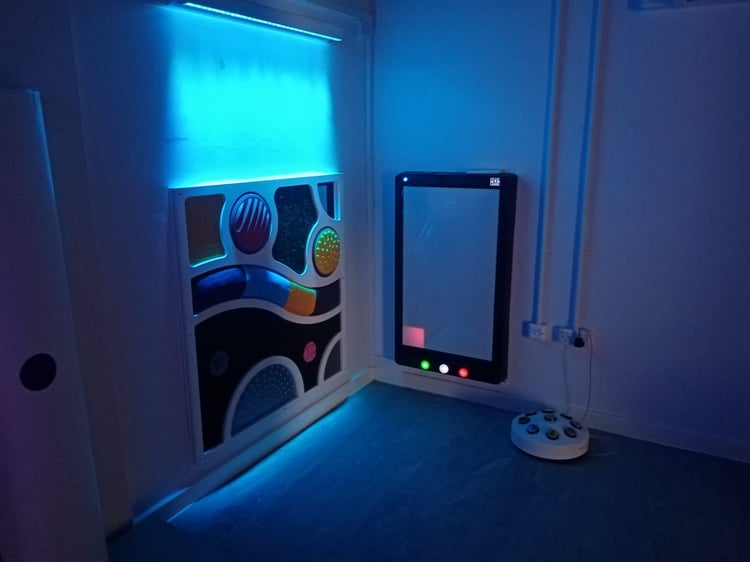What is Snoezelen®?
Snoezelen multi-sensory environments are, by nature, relaxing spaces that help to reduce agitation and anxiety, but they can also engage and delight the user, stimulating reactions and encouraging communication.
Stimulation:
Snoezelen® Multi-Sensory Environments and products can be used to stimulate users by providing exciting visuals, high tempo music and sounds, invigorating smells and textures to explore.
Relaxation:
Snoezelen® Multi-Sensory Environments products and environments can be used to calm and reduce agitation through the use of gentle lighting, soothing sounds, relaxing aromas and through touch.
Therapy:
We have been providing Occupational Therapists and health professionals with a Snoezelen® Multi-Sensory tool-kit to provide therapy for over 30 years. From portable resources to bespoke multi-sensory environments, we have solutions that can help.
Development:
Snoezelen® Multi-Sensory Environments can be used as a learning and developmental tool. It can be used for colour matching, understanding of cause and effect, and creating themed environments for teaching.
The Senses
The world is full of sensory stimuli. Some individuals are not able to organize and respond appropriately to this stimuli, others have lost skills due to accident or illness, and some others lack the ability or freedom to make choices to balance their sensory lives. For these individuals the world may be a confusing and frightening place, full of over- or under-stimulation. They may behave inappropriately and act or respond in ways others do not understand.
The five senses with which we are most familiar are:
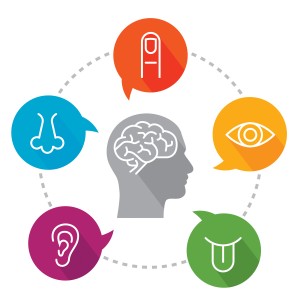 |
|
Two senses with which we may not be as familiar are:
- Vestibular —This sense puts balance into our lives. It provides information about movement, gravity, and changing head positions. It tells whether we’re moving or still, as well as the direction and speed of our movement. We may even tell whether we are vertically or horizontally positioned—even with our eyes closed.
- Proprioception —This sense processes information from our muscles, joints, and other body parts to provide us with an unconscious awareness of the position of our body parts in relation to each other—and their relation to other people and objects.
A Snoezelen® Multi-Sensory Environment may be used to educate, stimulate, relax, calm, or energize, as a multi-sensory experience or single sensory focus, simply by adapting the lighting, atmosphere, sounds, and textures to the needs of the client at the time of use. These environments transcend populations with its extraordinary flexibility, wide application, and positive outcomes. Moreover, a Snoezelen® MSE offers a highly motivating environment for users to enjoy sensory activities that are meaningful and appropriate, facilitated and shared by a therapist, teacher, or caregiver.
Contents:
Snoezelen® For Early Years
Snoezelen® For Learning Disabilities
Snoezelen® For Autism
Snoezelen® For Challenging Behavior
Snoezelen® For Early Years
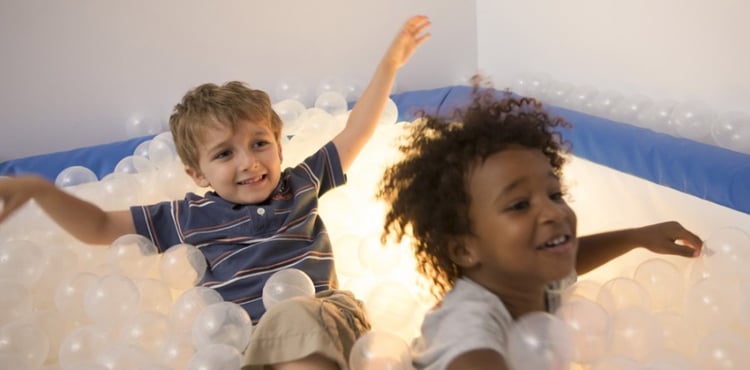
From the moment we wake, we continually experience a huge range of sensory information from the world around us; audible, visual, tactile, olfactory, gustatory, vestibular and proprioceptive as well as interoceptive. The information is fed through our peripheral nervous system, to our central nervous system and then we organize a response to the input. In short, we have to learn how to react to these different stimuli. How we choose to respond will depend on our previous experiences.
Sensory play is not only fun, but is a fundamental part of early human development.
The more exposure to stimuli, the more established the neural pathways in the brain will become and our response often becomes more efficient. We need to learn what to do if we smell fire, if something is too hot, or too cold, how to self-manage ourselves in accordance to the stimuli presented to us in everyday life.
Playing and experiencing sensory input in our early years helps us to develop our skills at reacting effectively to different input – forming what we like and dislike, understanding what things looks and feel like, and what they relate to. These basic elements help us organize our responses - the way in which we make decisions to act or behave, becoming the foundation of our human selves and often part of our unconscious functioning.
As well as developing sensory processing, encouraging young children to engage with different activities can improve fine and gross motor skills and enable professionals and parents to watch and assess a child’s ability levels in an informal manner. Observation may highlight specific needs or sensitivities to certain types of input – such as light or sound and enable support to be purposefully offered.
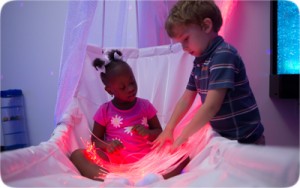
There are so many different parts of a multisensory environment that can help children explore their senses and develop their processing skills. These might be small items that are bought into the space for play, such as small tactile balls, objects that light up or switches that help children understand cause and effect. Fixed items such as bubble tubes offer opportunities for observing movement, counting inclusions such as fish or balls, feeling vibration, and discrimination between different textures and temperatures.
The teacher, healthcare professional or parent are offered a multitude of different opportunities to play, explore, and start to learn – it is an environment where the emphasis is on being creative and developing tailored meaningful activities for the young child you are nurturing.
Snoezelen® For Learning Disabilities
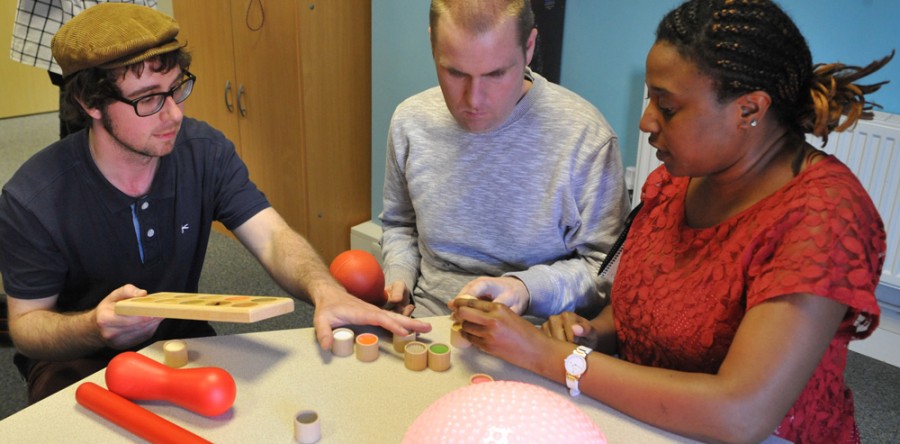
This area of support can be extremely complex. Clients may have a diverse range of need and different diagnoses that impact on how they experience life, the challenges they face, and level of support that they require. The combination of these very unique needs can affect cognition and/or physical functioning.
People may have impaired ability to understand, communicate, or process information, making effective decision making, engaging everyday activities (both leisure and ADLs), socializing and learning new skills, in some cases, very challenging. Support often focuses on trying to enable people to be as independent as possible while being aware of their personal needs.
Multi-Sensory Environments (MSEs) can provide a space where a variety of interventions can be tailored to meet a need (or needs) quickly and easily, whether it be therapeutic, educational, or focused on using sensory equipment to calm, soothe, or stimulate. Object recognition and context, as well as following direction and sequencing activities, for example, can be purposeful goals.
If we take an example of carrying out a specific ADL, such as tying a shoelace for example, one can use an MSE to concentrate on learning this particular activity. A system with projection within the MSE can be tailored to show various multimedia to suit the learning needs of the individual. This can be particularly beneficial. Our clients use these in various ways to suit the user by playing videos of the activity being carried out, using static photographs in sequence, using simple text and words, recognizable symbols/illustrations etc.
Storytelling also can be wonderful in a MSE as the whole room can be used to create an immersive environment. If telling a tale for example, about the sea, small tactile items could be bought into the space such as sand or shells for the user to touch and feel, while the breeze blows (using a fan), an aroma panel emits scent of the sea, the sounds of the sea can be heard, and the whole room can be programmed in blues and yellows. One can supplement this with perhaps words or images from the book.
Again, as with all therapeutic, educational, or play experiences, the limits using an MSE are with the imagination of the facilitator and the possibilities are endless.
Snoezelen® For Autism
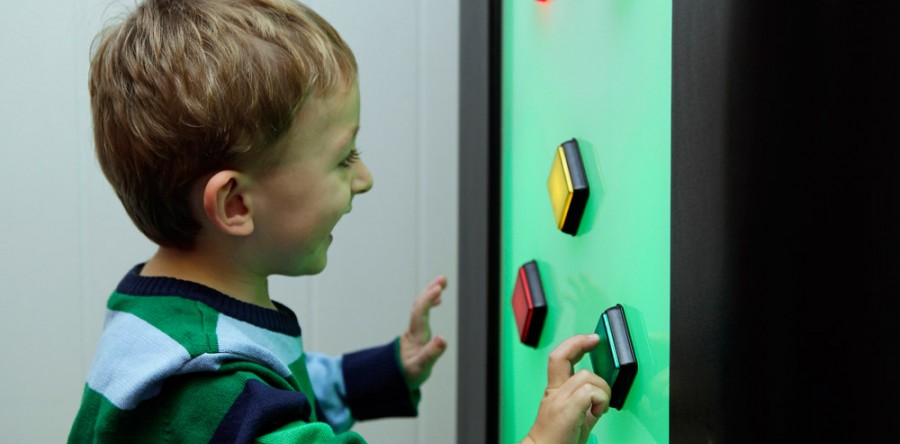
Snoezelen Multi-Sensory Environments provide the tools and a suitable, gradable and safe environment in which Health and Social Care professionals can carry out assessments and interventions.
Treatment and care should take into account individual needs and preferences but also be flexible enough to respond to changing needs as the individual matures or responds to treatment.
Sensory play is not only fun, but is a fundamental part of early human development.
Snoezelen Multi-Sensory rooms are individually designed according to user briefs and specifications. The whole environment can be adapted and the rooms personalized, graded, and tailored to the needs of the individual. Meaningful sounds, lighting, videos, and products can be themed to the interests of the user or specific learning goals.
Where parents or care professionals need to take into account an individual's sensory sensitivities to lighting, noise levels and the color of walls and furnishings, a Snoezelen sensory room is ideal.
Snoezelen® For Challenging Behavior
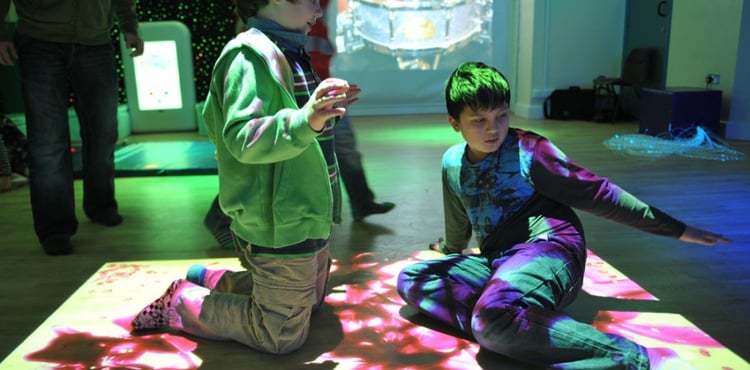
People across the full age range can experience difficulties with coping with life’s changes.
When people experience life changes, and find it difficult to cope, negative thoughts can build and emotion can be displayed/expressed in ways that society find hard to cope with and understand. There are many difficult behaviors that services encounter including chewing and eating non-food items, spitting, screaming and shouting, hitting, and swearing. Service users can pose a risk to others or harm themselves. Restructuring thinking patterns via talking therapy may be a solution, which can take place in a traditional multi sensory area with inclusions such as mirror balls, projectors, bubble tube, music...all selected to calm and soothe the individual receiving the therapy. Clients, however, may opt to create a very different intervention such as de-escalation spaces for their service users who have more complex needs.
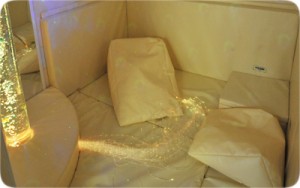
These might be rooms that have thick cushioned walls and floors, and can be considered controversial by some. These spaces enable individuals who want or need to engage in throwing their bodies against the floor or wall, or seek repeated impact with a particular part of their body to self soothe or obtain proprioceptive/tactile input (via a fist or head for example) to do so in a safe place with the minimum possible risk. Some of these rooms may include calming elements such as colored lighting, music or scent that can be chosen by the service user so they can personalize the area.
Some clients choose a more activity-based intervention. For example, clients who experience a build-up of anger and feel that they want to hit at something or are sensory seekers and do so for self-management may find interactive wall panels useful. An example of a product that can meet these needs is Cardiowall, a game designed to be struck at force with many different elements of grading and progressively difficult activities. One is gaining the input they need while focusing and concentrating on an activity that can be graded (altered to be made easier or more difficult), using hand/eye co-ordination, gross motor function, or orientation to complete the task.
Some clients may take a different perspective and choose a space that is designed for more interactive play. Soft play environments enable individuals to gain the sensory input they seek, possibly throwing their bodies around the space with minimal harm. Although these aren’t traditional Snoezelen Multi-Sensory Spaces, there is growth in multipurpose spaces. Spaces that include a mix of interactive areas, like ball pools, where people can experience a variety of tactile input (from the shape of the balls and, if selected, vibration). Ball pools can also be lit from the base, and provide music, with the client being able to select their choice of color and music – a personalized multi sensory experience!
Snoezelen® And Occupational Therapy

Occupational Therapy is a profession that concentrates on enabling people to carry out the things that they want to do, or need to do, in their lives. Assessing cognitive ability and physical functioning level, as well as identifying methods of engagement pertinent to the individual, is an essential element of clinicians planning and providing effective care provision.
Snoezelen Multi-Sensory Environments (also known as 'sensory rooms') provide a unique interactive space which offers the user a range of tactile, visual, scented, and interactive activities to engage with. Many can be easily graded to provide appropriate activities for a range of sensory, cognitive, fine motor and gross motor skill levels. Clinicians can use this equipment to conduct non-standardized assessments of the clients’ ability to engage or use these activities, identifying need and to determine suitable interventions.
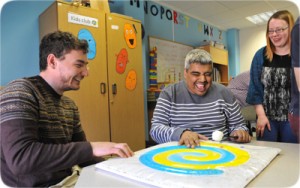
The equipment can be used to engage clients in simple, focused activity to avoid sensory overload, for example, trying to improve and increase levels of attention, concentration and ability to orientate to a task (such as turning everything off in a sensory space except for one piece of equipment and facilitating them to watch something). More complex activities might be learning sequencing of an Activity of Daily Living, or perhaps from a mental health perspective, using guided relaxation to calm and soothe in a safe place, or to learn new coping strategies and self-management techniques.
The activities can be graded up or graded down according to need. For example, if a client is mildly visually impaired and enjoys tactile input and a particular color, but a therapeutic goal is to work on improving the range of motion on an upper limb or fine motor skills, one might consider selecting a ball bubble tube with large colored balls that float gently up and down so the client can see the movement. The activity could be to get them to touch the ball tube, set to their favorite color and then ask them to reach and touch (maybe count) the balls as they float upwards or downwards.
A client may perhaps have a difficulty with a certain noise that causes them anxiety – perhaps a hair dryer or the sound of an engine. If the client enjoys a particular activity in the Snoezelen Multi-Sensory Environment such as interacting with a wall panel, one might consider playing the noise very quietly in the background and carefully, over time turn this up louder and louder while they are occupied with the other activity – with the aim, ultimately, of helping someone get used to the sound in a safe environment.
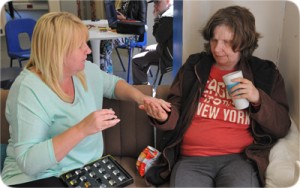
If working in pediatrics, if a client likes a certain toy, and you are trying to encourage them to use fine motor skills, this object could be partially “hidden” under fiber optics and more or less strands used to make “finding” it easier or more difficult. To encourage vocalization or movement one might use a sound responsive piece of equipment and encourage clients to jump, clap or play a musical instrument to get a light or sound reward.
One might use an interactive floor projection with personalized uploaded pictures of a favorite toy or object for cognitive purposes - to prompt conversation, memory recall for example. You may use this equipment to encourage fine or gross motor movements as part of a physical therapy goal. One can use small hand movements, holding a bat, to break colored light beams (cylindrical grip) or use upper or lower gross motor movements to break the beams to play a favorite tune or play video.
In conclusion, a Snoezelen multi sensory room can be adapted and used in a variety of ways to meet physical, sensory and cognitive needs.
Snoezelen is the leading global brand of Multi-Sensory solutions, who Play'n'Learn are the exclusive design partners and distributors for in NZ
.webp?width=251&height=192&name=041%20(1).webp)
Get in Touch
Enquire for more information and tell us what you need help with.


.jpg)
